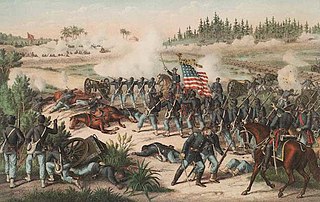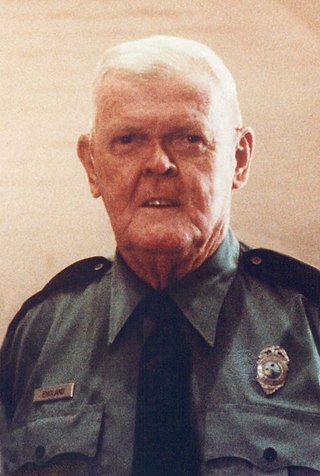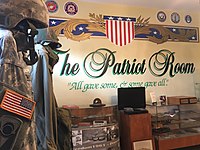
Baker County is a county in the U.S. state of Florida. As of the 2020 census, the population was 28,259. Its county seat is Macclenny. The county was founded in 1861 and is named for James McNair Baker, a judge and Confederate Senator.

Columbia County is a county located in the north central portion of the U.S. state of Florida. As of the 2020 census, the population was 69,698, up from 67,531 at the 2010 census. Its county seat is Lake City.

Lake City is a city in and the county seat of Columbia County, Florida, United States. As of the 2020 census, the city's population was 12,329, up from 12,046 at the 2010 census. It is the principal city of the Lake City Micropolitan Statistical Area, composed of Columbia County, as well as a principal city of the Gainesville—Lake City, Florida Combined Statistical Area. Lake City is 60 miles west of Jacksonville.
The history of Florida can be traced to when the first Paleo-Indians began to inhabit the peninsula as early as 14,000 years ago. They left behind artifacts and archeological evidence. Florida's written history begins with the arrival of Europeans; the Spanish explorer Juan Ponce de León in 1513 made the first textual records. The state received its name from that conquistador, who called the peninsula La Pascua Florida in recognition of the verdant landscape and because it was the Easter season, which the Spaniards called Pascua Florida.

The Battle of Olustee or Battle of Ocean Pond was fought in Baker County, Florida on February 20, 1864, during the American Civil War. It was the largest battle fought in Florida during the war.

Olustee Battlefield Historic State Park is a Florida State Park in the Osceola National Forest, near the town of Olustee. The site of Florida's largest Civil War battle, the Battle of Olustee. The park is located 50 miles (80 km) west of Jacksonville and 15 miles (24 km) east of Lake City, on U.S. 90. It was one of the first parks in the Florida State Park system.

Florida participated in the American Civil War as a member of the Confederate States of America. It had been admitted to the United States as a slave state in 1845. In January 1861, Florida became the third Southern state to secede from the Union after the November 1860 presidential election victory of Abraham Lincoln. It was one of the initial seven slave states which formed the Confederacy on February 8, 1861, in advance of the American Civil War.

The Fort Walton Mound (8OK6) is an archaeological site located in present-day Fort Walton Beach, Florida, United States. The large platform mound was built about 850 CE by the Pensacola culture, a local form of the Mississippian culture. Because of its significance, the mound was designated a National Historic Landmark in 1964.

The May-Stringer House, home of the Hernando Heritage Museum, is a historic residential building in Brooksville, Florida, United States. It is located at 601 Museum Court. On March 8, 1997, it was added to the National Register of Historic Places.

The Museum of Florida History is the U.S. state of Florida's history museum, housing exhibits and artifacts covering its history and prehistory. It is located in the state capital, Tallahassee, Florida, at the R. A. Gray Building, 500 South Bronough Street, named for Robert Andrew Gray.

Joseph Finegan, sometimes Finnegan, was an American businessman and brigadier general for the Confederate States Army during the American Civil War. From 1862 to 1864 he commanded Confederate forces operating in Middle and East Florida, ultimately leading the Confederate victory at the Battle of Olustee, the state's only major battle. He subsequently led the Florida Brigade in the Army of Northern Virginia until near the end of the war.
Lassie Moore Goodbread was an American farmer and educator who, in 1925, became the first woman to enroll at the University of Florida in the College of Agriculture. In 2000, Goodbread was named a Great Floridian by the State of Florida.

Howard S. England, was the principal individual responsible for the transformation of Fort Zachary Taylor from a forgotten eyesore to a popular historic landmark and state park in Key West, Florida.
Confederate monuments and memorials in the United States include public displays and symbols of the Confederate States of America (CSA), Confederate leaders, or Confederate soldiers of the American Civil War. Many monuments and memorials have been or will be removed under great controversy. Part of the commemoration of the American Civil War, these symbols include monuments and statues, flags, holidays and other observances, and the names of schools, roads, parks, bridges, buildings, counties, cities, lakes, dams, military bases, and other public structures. In a December 2018 special report, Smithsonian Magazine stated, "over the past ten years, taxpayers have directed at least $40 million to Confederate monuments—statues, homes, parks, museums, libraries, and cemeteries—and to Confederate heritage organizations."
The Civil War Trust's Civil War Discovery Trail is a heritage tourism program that links more than 600 U.S. Civil War sites in more than 30 states. The program is one of the White House Millennium Council's sixteen flagship National Millennium Trails. Sites on the trail include battlefields, museums, historic sites, forts and cemeteries.

John William Pearson was an American businessman and a Confederate Captain during the American Civil War. Pearson was a successful businessman who established a popular health resort in Orange Springs near Ocala as well as a hotel, grist mill and a machine shop. Orange Springs was a popular destination for tourism in northern Marion County until the opening of Silver Springs and Ocala by steamboat after the American Civil War. Pearson also owned 20 slaves.

Edmund Kirby Smith is a bronze sculpture commemorating the Confederate officer of the same name by C. Adrian Pillars that was installed in the United States Capitol Visitor Center as part of the National Statuary Hall Collection from 1922 to 2021. The statue was gifted by the state of Florida in 1922.

William H. Kendrick known as Captain Bill Kendrick was a soldier, state senator, pioneer and lecturer in Florida. He has been referred to as "the original Florida cracker". Kendrick, Florida is named for him. He is also credited with naming Orlando.



















